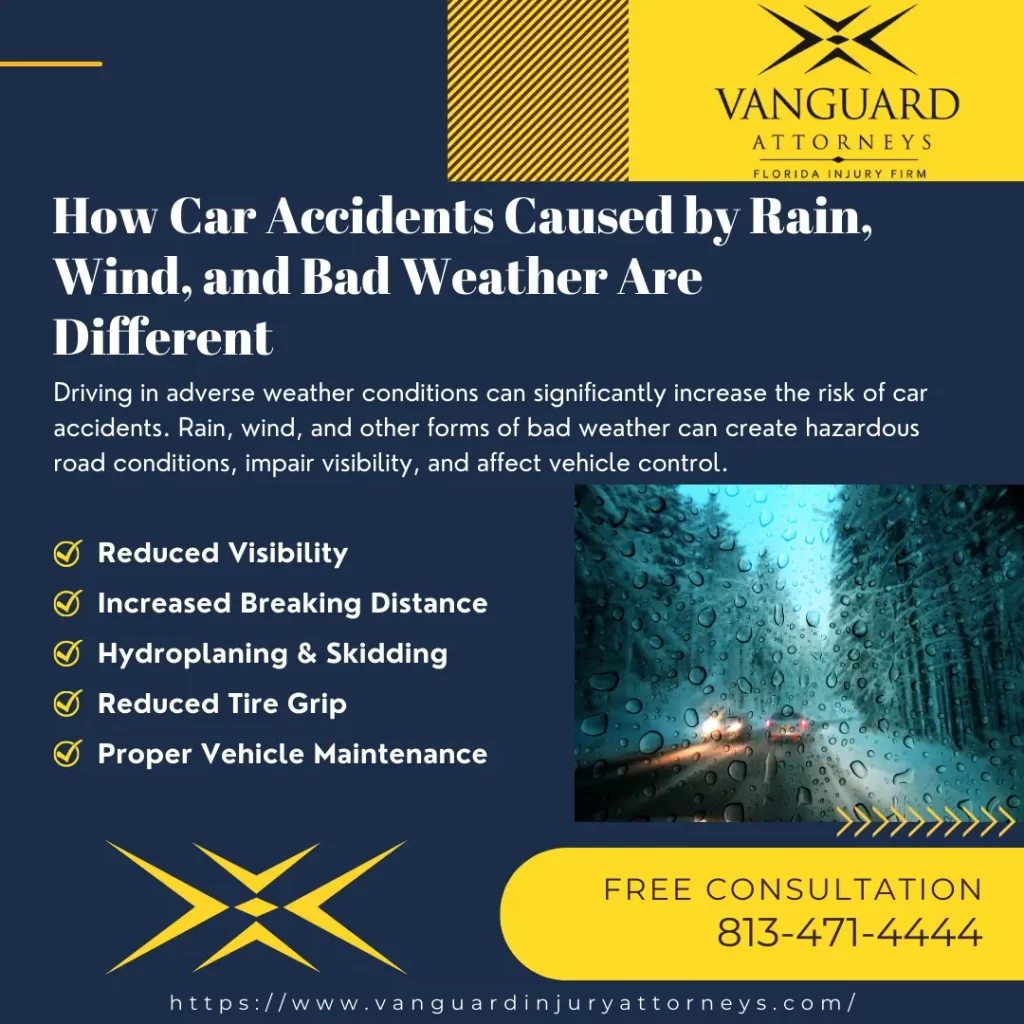How Bad Weather in Tampa, Florida Causes Car Accidents
Get a Free Consultation
How Tampa’s Bad Weather Increases the Risk of Car Accidents
Tampa, Florida is known for heavy rains and thunderstorms. These adverse weather conditions significantly increase the risk of car accidents. Rain, wind, and other forms of bad weather can create hazardous road conditions, impair visibility, and affect vehicle control. Vanguard Attorneys, Tampa’s leading personal injury law firm, knows how car accidents caused by rain, wind, and bad weather are different. Today we share with you some of our insights into handling the legal aspects of such accidents.
Reduced Visibility Due to Fog
One of the primary challenges of driving in bad weather is reduced visibility. Heavy rain, fog, or snow (it does snow in Florida from time to time) can limit a driver’s ability to see the road, other vehicles, and potential hazards. This decreased visibility increases the likelihood of rear-end collisions, sideswipes, and accidents at intersections.
According to the Federal Highway Administration, approximately 21% of all vehicle accidents are weather-related, with reduced visibility being a significant contributing factor. Drivers must exercise caution and adapt their driving behaviors to account for reduced visibility in adverse weather conditions.
Increased Braking Distance on Wet Roads
Rain, wind, and bad weather conditions can affect the friction between tires and the road surface. Wet roads become slippery, making it more difficult for vehicles to come to a stop. Hydroplaning, which occurs when a layer of water prevents tires from maintaining contact with the road, is a common risk in heavy rain.
Drivers should allow for increased braking distance and maintain a safe following distance to compensate for the reduced traction on wet or slippery roads. Failure to do so can result in rear-end collisions and loss of vehicle control.
Hydroplaning and Skidding in Heavy Rain
Hydroplaning is a significant concern when driving in heavy rain. When water accumulates on the road surface faster than it can be displaced by the tires, it can cause the vehicle to lose traction. This can lead to skidding, spinning out of control, or colliding with other vehicles or objects.
In windy conditions, strong gusts can also affect the stability of vehicles, especially high-profile vehicles such as trucks, vans, and SUVs. Windy conditions can cause vehicles to drift into other lanes or off the road, potentially resulting in collisions.
Reduced Tire Grip Makes Quick Turns More Hazardous
Wet roads can significantly impact tire grip, making it more challenging to navigate turns and curves. When taking turns too quickly in the rain, vehicles may skid or slide out of control, leading to accidents. Additionally, heavy rain can cause standing water on roadways, making it difficult for drivers to maintain control of their vehicles.
It’s crucial for drivers to slow down and approach turns and curves with caution in inclement weather. Adapting driving speed and using appropriate tires for rainy conditions can help reduce the risk of accidents caused by reduced tire grip.
Proper Vehicle Maintenance Is Critical
Driving in bad weather requires well-maintained vehicles to ensure optimal safety. Faulty windshield wipers, worn-out tires, or malfunctioning brake systems can exacerbate the risks associated with adverse weather conditions.
Regular vehicle maintenance is essential for safe driving in all weather conditions. This includes checking tire tread depth, replacing windshield wipers, and ensuring the functionality of brakes, headlights, and other safety features.
Car accidents caused by rain, wind, and bad weather pose unique challenges for drivers. Reduced visibility, increased braking distance, hydroplaning, and reduced tire grip are among the factors that contribute to the heightened risk of accidents in adverse weather conditions. By understanding these differences, drivers can take necessary precautions to minimize the chances of accidents and injury.
If you or a loved one have been involved in a car accident caused by rain, wind, or bad weather, it’s crucial to call our experienced Tampa car accident lawyers. We will help protect your rights, assess liability, and pursue fair compensation for your injuries and damages.
